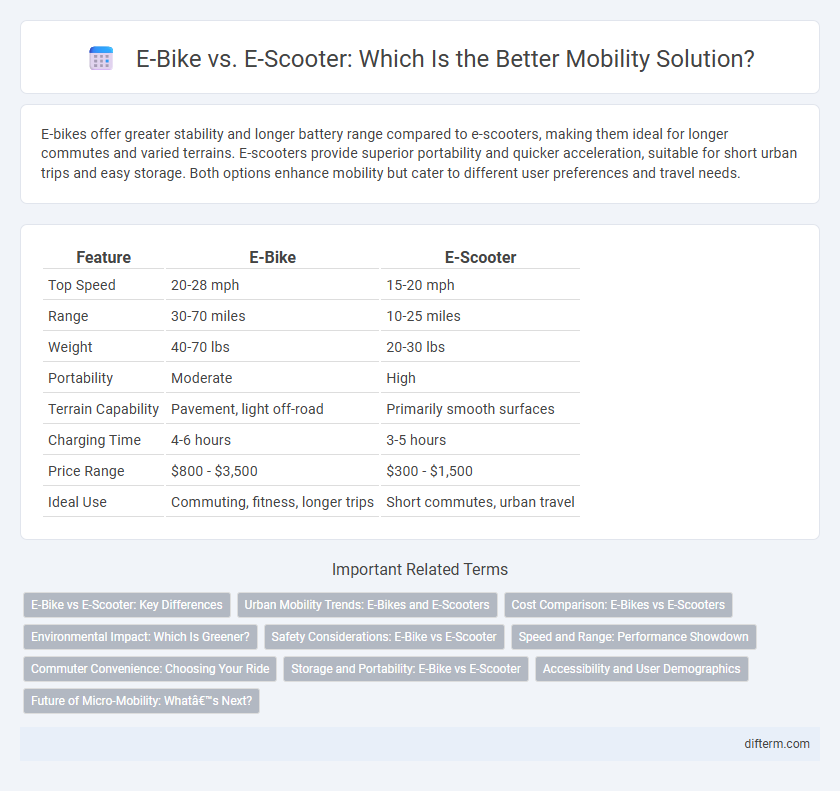E-bikes offer greater stability and longer battery range compared to e-scooters, making them ideal for longer commutes and varied terrains. E-scooters provide superior portability and quicker acceleration, suitable for short urban trips and easy storage. Both options enhance mobility but cater to different user preferences and travel needs.
Table of Comparison
| Feature | E-Bike | E-Scooter |
|---|---|---|
| Top Speed | 20-28 mph | 15-20 mph |
| Range | 30-70 miles | 10-25 miles |
| Weight | 40-70 lbs | 20-30 lbs |
| Portability | Moderate | High |
| Terrain Capability | Pavement, light off-road | Primarily smooth surfaces |
| Charging Time | 4-6 hours | 3-5 hours |
| Price Range | $800 - $3,500 | $300 - $1,500 |
| Ideal Use | Commuting, fitness, longer trips | Short commutes, urban travel |
E-Bike vs E-Scooter: Key Differences
E-bikes feature larger frames and pedals, enabling longer distances and exercise benefits, whereas e-scooters prioritize compactness and ease of use with standing platforms and handlebars. Battery capacity and motor power in e-bikes typically exceed those of e-scooters, resulting in higher speeds and extended range, ideal for commuting and fitness activities. Regulatory classifications and safety requirements vary by region, influencing usage permissions and helmet laws for both e-bikes and e-scooters.
Urban Mobility Trends: E-Bikes and E-Scooters
E-bikes and e-scooters are transforming urban mobility by offering eco-friendly, efficient, and convenient transportation options for short distances. E-bikes provide extended range and pedal-assisted power, making them ideal for longer commutes and diverse terrains, while e-scooters excel in compact design and easy maneuverability for quick, last-mile travel. Growing investments in charging infrastructure and shared mobility programs are accelerating the adoption of both e-bikes and e-scooters in metropolitan areas worldwide.
Cost Comparison: E-Bikes vs E-Scooters
E-bikes generally cost between $800 and $3,000, offering a higher initial investment but longer battery life and greater durability, making them more cost-effective for frequent use. E-scooters typically range from $300 to $1,200, providing a more affordable entry point with lower maintenance costs but shorter lifespan and limited versatility. Over time, the total cost of ownership for e-bikes tends to be lower due to fewer repairs and better performance on diverse terrains compared to e-scooters.
Environmental Impact: Which Is Greener?
E-bikes produce significantly lower carbon emissions per mile compared to e-scooters due to their more efficient battery use and longer lifespan. The production and disposal of e-scooter batteries contribute to higher environmental waste and resource depletion. E-bikes' higher energy efficiency and fewer replacement parts result in a smaller overall carbon footprint, making them a greener choice for sustainable urban mobility.
Safety Considerations: E-Bike vs E-Scooter
E-bikes generally offer enhanced stability due to larger wheels and a more robust frame, reducing the risk of accidents compared to e-scooters, which have smaller wheels and less balance control. E-scooters pose a higher risk for falls and collisions in urban environments because of their compact design and limited protective features such as brakes and lights. Helmets and protective gear are critical for both e-bike and e-scooter riders, but regulatory safety standards for e-bikes tend to be stricter, potentially leading to safer riding experiences.
Speed and Range: Performance Showdown
E-bikes typically offer higher speeds, averaging 20-28 mph, compared to e-scooters which usually reach 15-20 mph, making e-bikes more suitable for longer commutes. In terms of range, e-bikes can travel 40-60 miles on a single charge, while e-scooters generally have a range of 15-30 miles, highlighting the e-bike's advantage in endurance. Battery capacity, motor power, and rider weight significantly influence the performance metrics of both e-bikes and e-scooters.
Commuter Convenience: Choosing Your Ride
E-bikes offer greater range and pedal-assist options, making them ideal for longer commutes and varied terrain. E-scooters provide lightweight portability and quick start-stop capabilities, perfect for short urban trips and crowded environments. Commuters prioritize e-bikes for efficiency and exercise benefits, while e-scooters excel in compact storage and maneuverability.
Storage and Portability: E-Bike vs E-Scooter
E-scooters offer superior portability and ease of storage due to their lightweight design and compact folding mechanisms, making them ideal for urban commuters with limited space. E-bikes, while heavier, often feature removable batteries and foldable frames but require more room for storage and are less convenient to carry on public transport. Choosing between an e-bike and an e-scooter hinges on balancing storage constraints with the need for durability and ride comfort.
Accessibility and User Demographics
E-bikes offer greater accessibility for diverse user demographics due to adjustable seating and pedal support, accommodating riders with varying physical abilities. E-scooters appeal primarily to younger urban commuters seeking lightweight, easy-to-maneuver options for short distances. The user base for e-bikes tends to include older adults and those with mobility challenges, while e-scooters attract tech-savvy individuals prioritizing convenience and portability.
Future of Micro-Mobility: What’s Next?
E-bikes and e-scooters are pivotal to the future of micro-mobility, with e-bikes offering extended range and higher speeds ideal for commuting, while e-scooters provide compact design and ease of use for short urban trips. Advancements in battery technology, such as solid-state batteries, promise longer-lasting rides and faster charging times, shaping how micro-mobility devices will integrate into smart city infrastructure. Integration with AI-powered traffic management systems and IoT connectivity is expected to enhance safety, efficiency, and user experience, positioning e-bikes and e-scooters at the forefront of sustainable urban transport.
e-bike vs e-scooter Infographic

 difterm.com
difterm.com